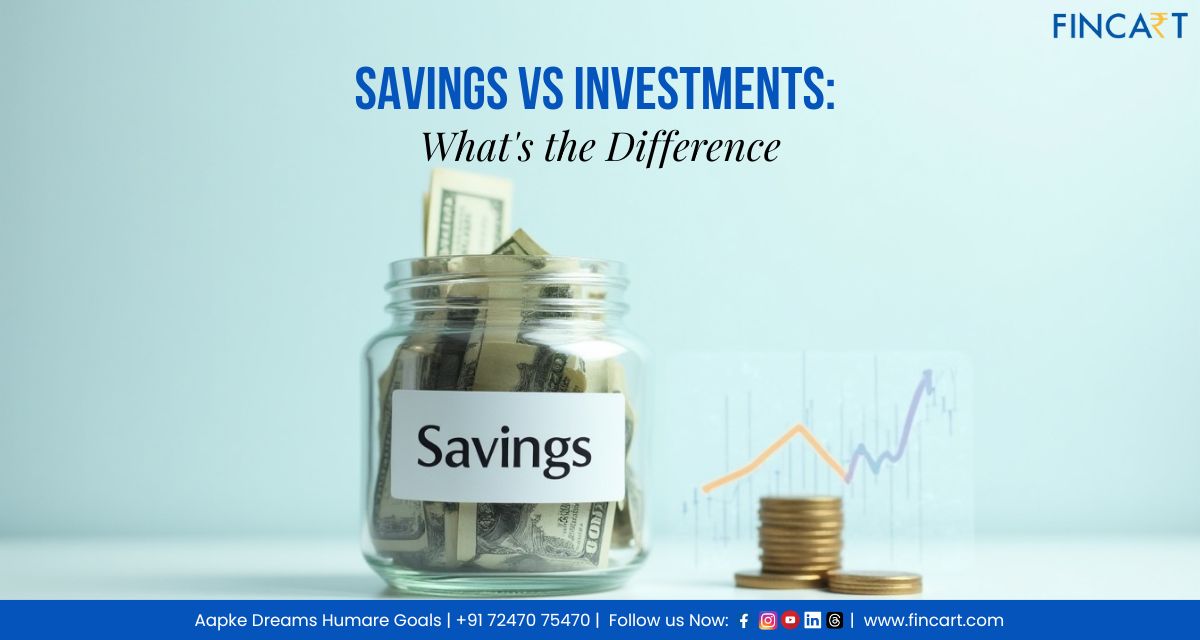Many of us grew up with a gullak at home. When we’d drop our pocket money into it, we wondered about all the amazing things we could buy someday. And when the time finally came to break it, we’d happily spend that money on toys, sweets, and whatnot. Looking back, wasn’t a gullak kind of like our first bank account? Anyway, that little gullak taught us one of life’s most important lessons. Save small amounts consistently, and one day it becomes enough to get what we want.
But a gullak only teaches you how to collect money. You drop coins in, they pile up, and that’s it. They don’t grow on their own. So we’ve learnt how to save, but we rarely get lessons on how to grow that money. That part comes much later in life. We begin to realise that saving alone isn’t enough to achieve the big goals. We also need to put our money to work, that is, invest.
Both saving and investing are important habits as they shape our financial future together. So in this blog, let’s understand what Savings vs Investments mean, how they differ, and when you should choose one over the other.
What are Savings?
Simply put, savings refer to the income left after subtracting expenses. For example, let’s assume Raj earns Rs. 50,000 every month. He has Rs. 10,000 left after paying all his essential and non-essential expenses. These Rs. 10,000 are his savings for that month, kept in a savings account. Now, Raj wants to buy a new phone next year that costs around Rs. 60,000. He decides to set aside Rs. 5,000 each month for 12 months to accumulate that amount. One can meet such short-term goals simply by saving money.
Another critical role of saving money is preparing for emergencies. Since the money is not tied up in any asset, you can access it quickly whenever needed. Expenses such as a sudden medical bill can pop up unexpectedly, but savings allow you to deal with them. They prevent you from using credit cards or selling assets.
Advantages of Savings
1. Easy Access to Money
One of the biggest advantages of savings is liquidity. You can access your money whenever you need. This benefit really shows its worth when it comes to emergencies. When unexpected expenses hit you, your money will be right there, ready to use. Before you even start investing, a good Investment planner will recommend building an emergency fund. This fund gives you a cushion so you aren’t forced to sell your investments prematurely.
2. Minimal Risk of Loss
Savings come with extremely low risk. Your principal amount stays safe, and the chances of loss are negligible. This is a major advantage of Savings vs Investments.
3. Great for Short-term Goals
For short-term goals, the priority is to keep your money safe. You’ll need to use it in a year or two, which is why saving it makes perfect sense. When goals are that close, they don’t demand long-term planning or exposure to risk. You can simply set some money aside regularly and withdraw it when you need it.
4. Builds Financial Discipline
To save money, you need to make sure that you’re not spending more than your income. Doing this regularly helps you build control over your finances. It also teaches you how to budget effectively and how you can cut back on expenses that don’t matter.
Savings not only help you tackle debt, but they also become the money you later put into investments. That’s why learning to save regularly is one of the most important financial habits you could develop.
Disadvantages of Savings
1. Very Low Yield
The biggest drawback of only saving regularly is that your money doesn’t work very hard for you. For example, a bank savings account pays anywhere between 2% to 4% interest per year. You may think the money’s value is rising when, in fact, it’s not even outpacing inflation. The result is that your money does not grow meaningfully.
2. Inflation Erodes Your Money’s Value
Inflation eats into the purchasing power of your money. Let’s understand this with an example. Suppose you’ve managed to save Rs. 1 lakh in your savings account, which pays you an interest of 3% per annum. At the end of the year, your balance will grow to Rs. 1,03,000. This slight increase alone may make you think that your money has grown. In reality, it hasn’t kept up with rising prices. Why’s that?
If inflation during the same year is 6%, something that cost Rs. 1 lakh last year will now cost Rs. 1,06,000. So even though your bank balance rose, it can no longer buy the same thing. In this case, your money’s value has gone down.
One way to deal with this is to park savings in instruments that offer returns closer to inflation. Examples of such instruments include FDs and post office schemes. But when you choose these options, you lose the liquidity of a savings account. And even if these instruments keep up with inflation on paper, the story can change after taxes.
3. Not Very Effective For Long-term Goals
If you want to go on a vacation in 6 months, savings will do the trick. But what about buying a home? Or funding your child’s education 15 years from now? Those require significant amounts of money. Since savings grow at a slow rate, reaching long-term goals becomes extremely difficult. Alone, they can find it hard to match the rising costs of education and property. That’s why investing becomes essential to reach faraway goals.
4. Opportunity Costs
If all your money sits in a savings account, it misses out on the chance to earn more through investments. This missed opportunity to make higher returns is known as opportunity cost.
For example, if you keep Rs. 1 lakh in a savings account earning 3%, you’ll make Rs. 3,000.
But if you invest that money in a hybrid fund earning even 10%, you could earn Rs. 10,000. A difference of Rs. 7,000 in a single year. Over 10 to 20 years, the gap becomes massive. If you only save and don’t invest, you lose out on what your money could have earned.
What is Investing?
So we saw that while saving money carries almost no risk, it also offers low returns. This poses a problem. If these returns fail to beat inflation, the real value of your money will go down. So how do you overcome this challenge? Can you make your money grow faster than inflation? Or at least ensure it keeps pace with the rising prices? Thankfully, it’s possible. That is the basic purpose of investing.
Investing puts your money to work. You buy assets that you expect will grow in the future. These assets, such as funds, stocks, gold, or real estate, offer the potential for growth at a cost – risk. Each investment carries with it a certain degree of risk.
There’s also a fundamental principle of investing called the risk/return tradeoff. According to this principle, the higher the potential return, the more risk you must be willing to take. Basically, safer investments tend to offer lower returns, and riskier ones offer higher growth potential.
For example, if someone simply wants to keep up with inflation, they can consider debt mutual funds. These lie on the lower end of the risk/return spectrum and generally offer moderate returns. On the other hand, if an investor wants higher long-term growth, they can choose equity funds or stocks. These offer better return potential but also come with more risk. This relationship helps you decide which investments fit your goals, horizon, and risk tolerance.
Also, note that there’s no guarantee your investments will always grow. Many factors affect how your investments perform. Investment advisory services consider these factors and focus on risk management to balance risk with returns. They also tailor investment strategies to your financial goals, investment horizon, and risk appetite.
Advantages of Investing
1. Higher Returns Than Savings
Investments offer the potential for higher post-tax returns compared to savings. They help grow your money at a rate that keeps up with, or exceeds, inflation.
2. Helps Achieve Long-term Goals
Savings alone won’t help you achieve goals like building a retirement corpus. Compounding interest and market growth can together help your money grow over several years.
3. Risk Is Manageable
Even though investments can be risky, the good news is that risk can be managed. One way to do so is by diversifying across different assets to balance out fluctuations. And if you feel unsure about how to manage risk, you can always reach out to an Investment consultant. Getting expert help is much easier today. You can connect with our qualified professionals online from the comfort of your home!
4. Variety
Today, investment options are abundant and serve almost every type of financial goal. From conservative instruments like bonds and debt funds to aggressive assets like equities, there’s something for everyone.
Disadvantages of Investing
1. Involves Risk
Every investment carries some level of risk. Across asset classes, debt instruments like bonds are safer than equity investments like stocks. Even within the same category, the level of risk varies. For example, a small-cap stock is far riskier than a blue-chip stock. They all share one common reality, which is the possibility of losing money. This is one of the main points in the Savings vs Investments debate.
This happens because various factors influence how an investment performs. Markets swing, companies underperform, interest rates change, and global events such as wars and pandemics happen. However, risk can be reduced to reasonable levels with the right strategies.
2. May Require Longer Investment Horizons
Most investments need time to grow. Many beginners invest in the stock market hoping to strike gold quickly, but leave disappointed. Equity shows its true potential only when you stay invested for years. That’s when you allow your money to compound and smooth out the ups and downs of the market.
3. Needs Patience, Knowledge, and Emotional Control
Successful investing demands a calm mind. You need knowledge to choose the right products and patience to stick to your plan.
Difference Between Savings vs Investments
Now that you understand the pros and cons of Savings vs Investments, check out how they differ:
| Factor | Savings | Investments |
| Meaning | Savings refer to the money you set aside from your income after all expenses and liabilities. | Investing is when you put money into assets like stocks, mutual funds, or gold with the expectation of growth. |
| Risk | Your money stays safe and accessible, so the risk is very low. | Varies from low to high depending on the asset. Some investments, such as bonds, are safer than others, like sectoral funds. |
| Returns | Savings generate very low returns that may not even keep up with inflation. | Investing gives you the potential for higher returns. If you choose your investments well, your post-tax returns can consistently and comfortably beat inflation. |
| Purpose | Used for building emergency funds and achieving short-term goals like planning a vacation. | Good for long-term goals like buying a house, retirement planning, children’s education, and wealth creation. |
When Should You Save and When Should You Invest?
Both saving and investing are important. If you recall, savings are simply the leftover income after taking care of all expenses and liabilities. So to invest, you need to save. Practising both regularly is the key to financial success.
When To Prioritise Saving
You Don’t Have an Emergency Fund:
An emergency fund is a reserve of money that is only used to handle unforeseen expenses. These include sudden hospitalisations, repairs, and situations, such as loss of employment. The thumb rule is to maintain funds equal to six months of your essential expenses. Having the safety of an emergency fund is essential before investing because:
- It allows you to make any ongoing EMIs payments.
- You can continue your regular investments like SIPs.
- It prevents you from taking on debt during tough times.
- You won’t need to sell any existing assets at poor prices.
You Have Short-term Goals:
Short-term goals can be achieved within 1 to 3 years. For such goals, you can either save your money or explore very low-risk investments like debt funds.
You are Repaying Debt
An Investment planner may recommend taking care of high-interest debt before putting money into investments. That’s because the interest can exceed what you might realistically earn from investing.
When To Prioritise Investing
You Already Have an Emergency Fund
If you’ve already built an emergency fund and have manageable debt, your basics are covered. You can now channel your savings into suitable investments to earn higher returns.
Your Goals Are Long-Term
For short-term goals, investing in aggressive assets is usually not recommended because the risk of loss is high. However, for longer-term goals, you can consider such investments. The longer your investment horizon, the more time your money has to recover from fluctuations.
You Want To Beat Inflation
A standard savings account rarely keeps pace with inflation, so your purchasing power will decline. Even higher-yield, less liquid savings instruments can struggle to outgrow inflation once taxes come into play. If your goal is to consistently beat inflation, a well-planned investment strategy is your best bet.
Conclusion
When it comes to Savings vs Investments, it isn’t a question of which one is better. It’s more about knowing when to save and when to invest. Savings are important for building emergency funds and achieving short-term goals. While they keep your money safe, they don’t earn high returns. In fact, if returns don’t keep up with inflation, your money isn’t truly ‘safe’ in terms of purchasing power.
Once you’ve saved enough for emergencies, it makes sense to redirect the surplus into investments. Investing can help you earn returns that beat inflation and achieve long-term goals. Yes, there is risk involved, but it can be managed. If you invest with a long-term perspective and align your choices with your goals and risk tolerance, your chances of success increase significantly. The earlier you start, the better. Your money gets more time to compound and weather market ups and downs.
For beginners, the biggest obstacle to investing is often confusion. But this is manageable, too. You can reach out to a professional for guidance, and they can help create personalised strategies to grow your wealth. Connect with one today!
FAQs for Savings vs Investments
Q: Should I focus on saving or investing first?
A: It’s a good idea to start by saving enough to build an emergency fund. Once that’s done, you can begin investing.
Q: What is the basic difference between Savings vs Investments?
A: Savings are for short-term goals and meeting emergency expenses. You don’t earn very high returns on savings, and they can fall short of inflation. Investments are riskier, but they grow your wealth and help you achieve long-term goals.
Q: Why do some people prioritise Savings vs Investments?
A: Some prioritise savings because:
- They are very conservative when it comes to risk comfort.
- They are pursuing many short-term goals.
- They feel more secure having easy access to money.
- They don’t understand how investing works.
- But with rising inflation, it is incredibly important to invest for long-term financial security.
Q: Is investing risky?
A: Yes, all investments carry some risk. Generally, the higher the potential return on investment, the greater the risk. But if you diversify and keep a long-term mindset, you can lower risk.
Q: What are some common mistakes that people make when investing?
A:
- Buying an asset without understanding how it works. (It’s risks, historical performance, liquidity, taxation, fees, horizon, etc.)
- Investing in products that don’t align with their risk tolerance and financial goals.
- Following investment tips from friends or influencers.
- Ignoring diversification.
- Making decisions out of fear and greed.
- Not having an emergency fund.




